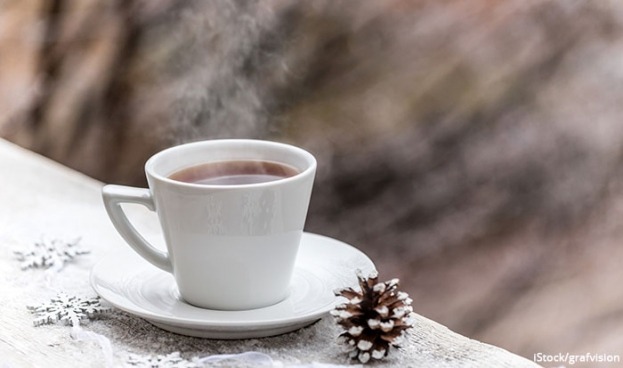Yes, the world may aspire to vacuousness, lost souls mourn beauty, insignificance surrounds us. Then let us drink a cup of tea. Silence descends, one hears the wind outside, autumn leaves rustle and take flight, the cat sleeps in a warm pool of light. And, with each swallow, time is sublimed.
― Muriel Barbery, The Elegance of the Hedgehog
For five years I lived entirely in the warm equatorial sun of coastal Ecuador, a constant summer, absent of seasons, of winter, of falling leaves and snow encrusted trees. It was lovely and summery and succulent to the skin. But my tea was unhappy. Iced tea was popular, yes, but tea gets tired of being pummeled by hulking, utilitarian ice cubes and guzzled down in sweaty glasses that leave rings on the table. Tea longs for winter. In cold weather, tea feels happy inside delicate china cups, sipped and savored, as if the meaning of its life is fulfilled; for it knows that it is warm and comforting, a simple balm of tranquility to the drinker’s otherwise fretful day.
I returned to North America with only a few items, sadly, not a teapot among them. Even before getting a stick of furniture for our apartment, I bought a teapot — first things first — and began brewing. My tea thanked me effusively.
With studied delight, I reacquainted myself with the elegance of soft white steam rising from the cup into the cold light of a winter morning. The cup of tea sits in repose as still and quiet as a monk in prayer. And yet, from that stillness rises ecstatic molecular activity of hot meeting cold -- tiny droplets of water drifting up in steamy swirls, leaps, and pirouettes. This reminds me that even when I am still and quiet as in meditation or reading or wool-gathering, my very existence somehow swirls up and out into the interconnected dance of the universe. I might seem solid enough sitting here in contemplation, but my cup of tea reminds me that I am actually made up of tiny droplets of experience unfolding in a universe of surprise and possibility, where everything influences everything else. And so it is: when the warmth of my prayers meets the coldness of the world, something happens. Truly, prayer itself is like the fragrant steam from a cup of tea, rising to mingle with the elements of the universe in ways of persuasion and love.
Tea can be a spiritual practice. A cup of tea interjected somewhere in the mix of meditation or prayer reminds us of the importance of keeping our interior selves warmed and alive and perhaps even boiling hot with passion for what we love and believe in. During times of stress, we can center ourselves in beauty and fragrance with a single cup of tea. The very preparation of the tea helps us perform a simple task with calming deliberation, mindfulness, and ritual meaning.
If we take a moment to think of the tea itself, we can imagine the path of its origination: those who picked, gathered, harvested, and cured the leaves, and how this cup supports their community and connects us to that different parts of the world in a very real way. And we wonder how they think and how they pray, and we make a space for them in our soul. All this expands our sense of self-in-relationship. We are reminded of our earthly dependence on one another.
Of course, tea is not just for quiet and solitary times. Our grandmothers might remind us of the Fifties, when middle-class women wore pearls and girdles and invited other women over for tea while their husbands entertained clients at three-martini lunches. We naturally deride the narrow box of those pre-feminist roles, as we should — but why throw the baby out with the bathwater? Forget the pearls and the girdles, but don’t forget the tea. Perhaps our conversation could be more evolved and diverse and honest and subversive than in the old days, but the tea thing — well, we really lost something by giving it up in the revolution.
It is good to offer tea in delicate china cups or, at the very least, a mug with some special meaning attached. No good ever came from second-flush Himalayan Darjeeling served in paper cups. If you’re going to drink tea, drink it with all the respect it deserves. For those of us steeped in the fragrance of theology, the cup can be like a chalice or a womb or an encompassing Presence.
Perhaps it is time to reach for your grandmother’s china cups from the old hutch and use them. Drink tea alone or drink tea with a companion. A cup of tea can be an entire ceremony, a private ritual, a tether to sanity amid the chaos of a cold and scary world — a world hell-bent on keeping us afraid and discontented and overly stimulated. It is a rebellious act to brew a cup of tea, to smile, to remain calm.
A cup of good tea, happy tea, tea accompanied by a book or a poem or a smile from across the table, opens the door to a quiet place of meaning amid the madness. It enlarges our souls as it calms the body. With every sip, imagine the comforting flow of divine companionship within your very taste buds.
Most of all, think of a cup of tea as a study in contrasts: ever-changing fluidity nestled inside the solidness of divine love — a love which, like a delicate china cup, holds us tenderly in eternal care.
So let us drink a cup of tea. May I pour?

 Let Us Drink a Cup of Tea
Let Us Drink a Cup of Tea